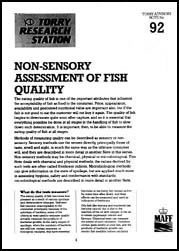Contents Index

Accompanying Notes
Table of Contents
TORRY RESEARCH STATION
TORRY ADVISORY NOTE No. 92
The eating quality of fish is one of the important attributes that influence the acceptability of fish as food to the consumer. Price, appearance, availability and perceived nutritional value are important also, but if the fish is not good to eat the customer will not buy it again. The quality of fish begins to deteriorate quite soon after capture, and so it is essential that everything possible be done at all stages in the handling of fish to slow down such deterioration. It is important, then, to be able to measure the eating quality of fish at all stages.
Methods of measuring quality can be described as sensory or non-sensory. Sensory methods use the senses directly, principally those of taste, smell and sight, in much the same way as the ultimate consumer will, and they are described in more detail in another Note in this series. Non-sensory methods may be chemical, physical or microbiological. This Note deals with chemical and physical methods; the values derived by such tests are often called freshness indices. Microbiological methods can give information on the state of spoilage, but are applied much more in assessing hygiene, safety and conformance with standards.
Crown copyright material is reproduced with the permission of the Controller of Her Majesty's Stationery Office.
This electronic document has been scanned using optical character recognition (OCR) software and careful manual recorrection. Even if the quality of digitalisation is high, the FAO declines all responsibility for any discrepancies that may exist between the present document and its original printed version.
Explains the nature and purpose of non-sensory chemical and physical methods for assessment of the quality or freshness of chilled fish and the deterioration of frozen fish. Discusses the advantages and disadvantages of non-sensory compared with sensory methods from a different perspective to Advisory Note 91. Generally describes what the tests measure in terms of the stages of autolytic or bacterial spoilage, and the deterioration of frozen fish including oxidative changes. Discusses the principles of a range of the most commonly used non-sensory quality tests for chilled and frozen fish, what is measured, what the values obtained mean, and the important additional information needed to put the results in perspective. Includes for chilled fish the chemical tests, hypoxanthine, K value, trimethylamine, ammonia, total volatile bases and histamine, and physical tests based on the electrical properties of the fish such as the Torrymeter; for frozen fish the chemical tests, dimethylamine, formaldehyde, extractable protein, peroxide value and thiobarbituric acid value. This Note should be read in conjunction with Notes 58 and 91.
(FAO in partnership with Support unit for International Fisheries and Aquatic Research, SIFAR, 2001).
What do the tests measure?
Do non-sensory tests
have advantages?
What methods are there?
Methods for chilled fish
Methods for frozen fish
Contents Index